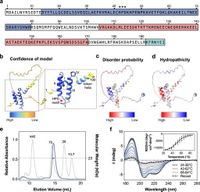Recent research has uncovered crucial insights into the role of the J-domain protein DNAJC12 in the pathogenesis of parkinsonism. The study reveals that pathogenic variants of DNAJC12 impair its interaction with tyrosine hydroxylase (TH), an enzyme integral to dopamine biosynthesis. The DNAJC12-TH complex has been shown to stabilize TH, delay its aggregation, and maintain its enzymatic activity, which is vital for normal neural function.
The researchers behind this study have characterized how DNAJC12 binds to TH, specifically elucidating the structural and functional implications of this interaction. By employing techniques like cryo-electron microscopy and crosslinking-mass spectrometry, they have depicted how two DNAJC12 monomers engage with each TH tetramer. This binding not only protects TH from aggregation but also enhances its interaction with Hsc70, a central player in protein homeostasis.
Tyrosine hydroxylase is essential for synthesizing dopamine, a neurotransmitter critical for motor control and other brain functions. Impairments in dopamine production can lead to severe neurological disorders, including parkinsonism. This connective tissue of TH deficiencies and DNAJC12 variants indicates a broader network of molecular interactions that sustain neuronal health. The identification of DNAJC12 as a cochaperone for TH opens new avenues for understanding and potentially treating dopamine-related diseases.
The study notes that while DNAJC12 could stabilize TH activity and inhibit the enzyme's aggregation, pathogenic variants of DNAJC12, specifically W175Ter, disrupt this protective mechanism. This mutation prevents the protein from effectively binding to TH, contributing to dopamine deficiency and the accompanying neurological symptoms in patients.
Further investigations revealed that DNAJC12’s interaction with TH is not merely a passive association; it actively reconfigures TH dynamics, ensuring its functionality remains intact even in the presence of detrimental mutations. Notably, the results indicate that DNAJC12 and dopamine can simultaneously bind to TH without obstructive interference, a finding that underlines a potentially additive stabilizing function of both molecules.
This research represents significant progress in elucidating the molecular underpinnings of dopamine synthesis regulation. Understanding the interplay between DNAJC12 and TH may not only shed light on the mechanisms underlying dopamine-related disorders but also pave the way for innovative therapeutic strategies.
The folding and binding characteristics of DNAJC12, in conjunction with its cooperativity with Hsc70, suggest a multifunctional role in maintaining protein homeostasis in the nervous system. Researchers advocate for expanded studies that explore the therapeutic potential of targeting the DNAJC12-TH interaction, especially in the context of parkinsonism and related disorders.




